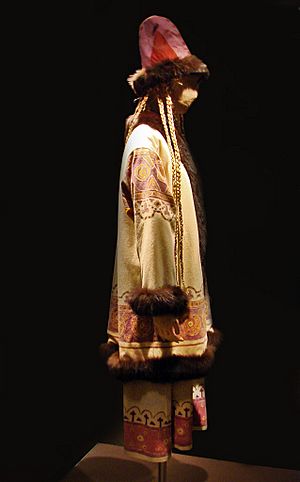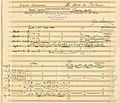The Rite of Spring facts for kids
The Rite of Spring (Le Sacre du Printemps) is a famous ballet with music by Igor Stravinsky. It tells a story in two main parts. Stravinsky came up with the idea for the ballet and wrote all the music. Nicholas Roerich designed the look of the show, including the sets and costumes. The dances were created by Vaslav Nijinsky, though Stravinsky wasn't a fan of them. He felt Nijinsky didn't understand music very well.
The ballet was first performed by a famous dance group called Ballets Russes, led by Sergei Diaghilev, in Paris on May 29, 1913. The first show caused a huge stir, with people shouting and arguing! But later performances were better received. Because the music and dancing were so difficult, it was only performed six times at first.
The Rite of Spring was brought back in 1920 by the Ballets Russes. By then, Nijinsky's original dances were forgotten. So, Leonide Massine created new dances, which Stravinsky liked. Years later, in 1940, Walt Disney used the music in his animated movie Fantasia. In the movie, the music played while dinosaurs roamed and volcanoes erupted.
Contents
Stravinsky's Powerful Music
The music for The Rite of Spring lasts about 40 minutes and is split into two main parts. It has a subtitle: "Pictures from Pagan Russia." Stravinsky's idea was to write music about ancient country people in Russia. They would perform a special dance called a fertility rite. This was a ceremony meant to bring good luck for the next year's harvest. In this old Russian dance, one young girl is chosen to dance until she dies. She is a sacrifice to the god of spring.
How the Music Was Created
The painter Nicholas Roerich first discussed the idea for this ballet with Stravinsky in 1910. Stravinsky started writing musical ideas for it while he was still working on another ballet called The Firebird. After that, he worked on Petrushka. Finally, in 1912, he could fully focus on The Rite of Spring. All these ballets were written for Sergei Diaghilev's Ballets Russes. This was a very famous group of Russian dancers who performed mainly in Paris, Europe.
The First Performance and Its Impact
The Rite of Spring had its very first performance on May 29, 1913, in Paris. The conductor was Pierre Monteux. The audience was shocked by the wild, primitive dancing and the strange, loud sounds from the orchestra. The music had unusual rhythms and chords. Vaslav Nijinsky's choreography (the dance moves) was completely different from traditional ballet. Nijinsky himself found it hard to work with Stravinsky and his challenging music.
Carl Van Vechten described the scene:
"Some people in the audience were angry. They thought the ballet was trying to ruin music as an art. They started making animal noises and shouting advice. The orchestra played, but you could barely hear it. A young man behind me stood up to see better. He was so excited that he started hitting my head with his fists! I was so caught up in the moment that I didn't even feel the blows for a while."
Marie Rambert heard someone in the audience yell, "A doctor… a dentist… two doctors…" The second performance, on June 4, was much calmer. According to Maurice Ravel, you could actually hear the whole piece that time.
The complicated music and strong dance steps made some people boo. They started to shout and whistle. People argued, and those who liked the show argued back. Then some people even started to fight! In the end, the police had to be called. Stravinsky was very upset and left the theater. The performance was a huge scandal, but this actually made people curious. Soon, the ballet became very famous. It was performed six more times that season, and there were no more interruptions.
Exploring the Ballet's Themes
The Rite of Spring is split into two main parts, and each part has several sections:
- Part 1: The Adoration of the Earth
- In the Introduction, we hear the arrival of spring. A bassoon starts all by itself on a very high note. Slowly, other instruments join in. It begins to sound like buzzing insects and other spring noises.
- In The Auguries of Spring – Dances of the Young Girls, we hear two musical chords played at the same time. Each chord is in a different musical key. This special chord, which is in two keys at once, is played strongly by the strings and eight horns. A gentle, rocking tune is heard on the cor anglais.
- This leads to The Game of Capture, where we hear a piccolo trumpet (a small, high-pitched trumpet).
- Round-dances of Spring features a country-like tune played by high and low clarinets. This is followed by a slow dance for strings and woodwind instruments. Then there is a big, loud sound, followed by quietness again.
- Games of the Rival Tribes uses timpani (kettledrums), low brass instruments, and horns to describe the fierce tribes.
- The Procession of the Sage is when the wise old man (the sage) enters. The music builds up to a big, exciting moment.
- Adoration of the Earth-The Sage is a short piece of very quiet music, leading to...
- Dance of the Earth, which brings Part One to a wild and energetic end.
- Part 2: The Sacrifice
- The Introduction describes the night. Many chords in several keys at once lead to a tune played by the strings.
- Mysterious Circles of the Young Girls. This is the part where one girl is chosen to die. Six solo violas play the tune, and an alto flute is heard. Trumpets and horns with mutes (devices that change the sound) interrupt the circling. Then, eleven heavy thumps from the strings and drums lead to…
- Glorification of the Chosen One. This is a big, exciting dance with loud horns, timpani, and bass drum.
- Evocation of the Ancestors. The elders (the wise old men) arrive to grand, powerful chords played by wind and brass instruments.
- Ritual Action of the Ancestors. We hear quiet, ticking chords and a duet (a piece for two players) for cor anglais and alto flute. Then trumpets and horns join in, and finally clarinets.
- Sacrificial Dance of the Chosen One. The “Chosen One” dances herself to death. The music is very energetic, with very irregular rhythms. The time signatures (how the beats are grouped) keep changing almost every bar (a small section of music). The work ends in a huge, powerful climax.
Unique Musical Style
Stravinsky's music in The Rite of Spring has many complex harmonies with dissonant (clashing) sounds. There are parts with polyrhythms (several different rhythms at once) and polytonality (music in several keys at once). The time signatures change often, and he frequently uses ostinati (repeated musical patterns).
Stravinsky wanted his music to show a lot of raw energy. Most composers would use many percussion instruments for this. However, even though two players are needed for the timpani, there aren't many other percussion instruments. Instead, the whole orchestra acts like a giant percussion instrument! Also, the music often sounds like Russian folkmusic.
Instruments in the Orchestra
The Rite of Spring uses a very large orchestra with some unusual instruments. Almost 100 musicians are on stage playing this piece! Here is a list of the instruments used:
- Woodwinds: piccolo, 3 flutes (one can also play piccolo), alto flute, 4 oboes (one can also play cor anglais), cor anglais, clarinet in E-flat and D, 3 clarinets in B-flat, A (one can also play bass clarinet), bass clarinet, 4 bassoons (one can also play contrabassoon), contrabassoon
- Brass: 8 horns in F (two can also play Wagner tubas), trumpet in D, 4 trumpets in C (one can also play bass trumpet), 3 trombones, 2 tubas
- Percussion: timpani (2 players, with at least 5 drums including a small timpano), bass drum, cymbals, tam-tam, crotales (small cymbals) in A-flat and B-flat, triangle, tambourine, guiro
- Strings: violins i, ii (16 first violins, 14 second violins), violas (12), violoncellos (10), double basses (8)
The Unique Dance Style
Nijinsky's dance moves were almost as shocking as the music! The story behind the dance is that a tribe sacrifices a young virgin girl each spring. They do this to please their gods and make sure their crops grow well. The dancers stand with their toes pointing inward (a pigeon-toed stance). Their movements are heavy and strong. They move together in groups, like they are performing an ancient ritual. They look like a primitive tribe doing a sacred ceremony. The ritual movements build up towards the sacrifice of the chosen girl. The Rite of Spring is seen as a link between traditional classical ballet and Modern dance.
Recreating the Original Ballet
Nijinsky's original dance steps have not been perfectly preserved over time. However, in recent years, people have tried to recreate his performance. They use costumes and set designs that look like the original ones from 1912.
The Rite of Spring in Fantasia
The Rite of Spring became even more popular when Walt Disney used some of its music in his animated movie Fantasia in 1940. In the film, the music is used to show the early life on planet earth, with huge dinosaurs walking around.
Images for kids
-
Stravinsky, sketched by Picasso, 1920
-
Sergei Diaghilev, director of the Ballets Russes from 1909 to 1929, as painted by Léon Bakst
-
Nijinsky in 1911, depicted by John Singer Sargent in costume for his role in Nikolai Tcherepnin's ballet Le Pavillon d'Armide
-
The New York Times reported the sensational Rite premiere, nine days after the event.
-
Dancers in Nicholas Roerich's original costumes. From left, Julitska, Marie Rambert, Jejerska, Boni, Boniecka, Faithful
-
Léonide Massine, who choreographed the 1920 revival
See also
 In Spanish: La consagración de la primavera para niños
In Spanish: La consagración de la primavera para niños












